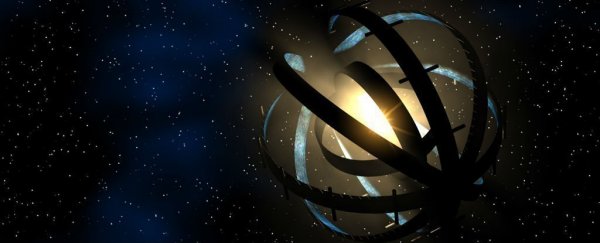For over a year now, scientists have been puzzling over the erratic light patterns coming from a star called KIC 8462852 - patterns so strange, we've never seen anything like it, and one astronomer even offered up the the possibility that an 'alien megastructure' has been messing with its emissions.
Now, after several hypotheses have failed to gain traction in the wider scientific community, there's a new explanation on the table, and it points to the last remaining dregs of a devoured planet.
Researchers from Columbia University suggest that KIC 8462852 swallowed a planet at some point in its lifespan, and the flickering light pattern we see is caused by remnants of this planet or its moons occasionally blocking the star's light.
This could explain both the sudden, intermittent dimming, and the more gradual decrease in the star's light that was observed between 1890 and 1989.
As we reported back in 2015, when a planet orbits a star, the star's brightness will periodically dip by around 1 percent, but KIC 8462852 - also known as Tabby's Star - has been experiencing erratic dips of up to 22 percent.
This huge disparity immediately got scientists speculating that something very, very big had been swirling around it.
The Columbia team says that if KIC 8462852 really did absorb a planet, the released energy would cause a sudden increase in brightness, so what we're seeing could just be KIC 8462852 returning to normal over time, with a few rocky leftovers for company.
The collision between planet and star might have happened some 10,000 years ago, the researchers estimate, but the recent dimming suggests KIC 8462852 may only now be digesting its meal.
To come up with the hypothesis, the team matched up previous research on KIC 8462852 with established pillars of outer-space physics like the Kozai mechanism, which figures out the variations in the orbits of planetary satellites.
The researchers also suspect this kind of planet and star collision could be more common than we've previously thought, if their calculations turn out to be correct.
"We estimated that if Tabby's Star were representative, something like 10 Jupiters would have to fall into a typical star over its lifetime, or maybe even more," lead researcher Brian Metzger told Leah Crane at New Scientist.
As with other ideas that have been floated about the star, scientists will be watching closely to see if this new hypothesis checks out as new data roll in, but keeping an eye on something over 1,000 light-years away isn't easy.
"These transits [light fluctuations] only last a few days, so when we see one, we have to alert all the telescopes and basically point every telescope we have at Tabby's Star," says Metzger.
The case is far from closed yet: other scientists think the flickering light from KIC 8462852 could be caused by cosmic debris somewhere between the star and our planet, rather than debris left behind by a swallowed planet or its moons.
And we wouldn't be surprised if there are even more twists to come in this particular tale. However, the new hypothesis certainly fits the facts as we know them so far.
"This paper puts a merger scenario on the table in a credible way," astrophysicist Jason Wright from Penn State University, who wasn't involved in the research, told New Scientist. "I think this moves it into the top tier of explanations."
The findings are due to published in an upcoming edition of the Monthly Notices of the Royal Astronomical Society.
